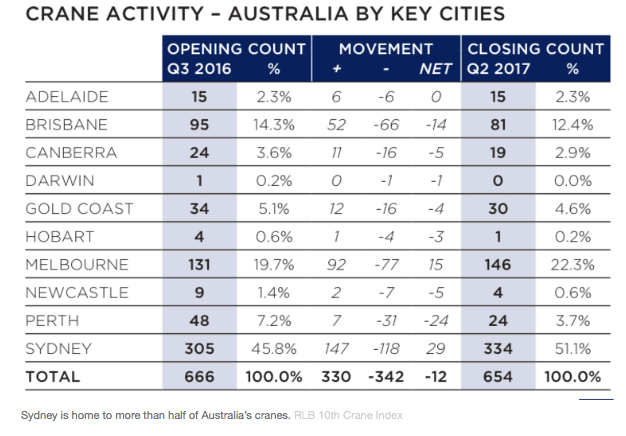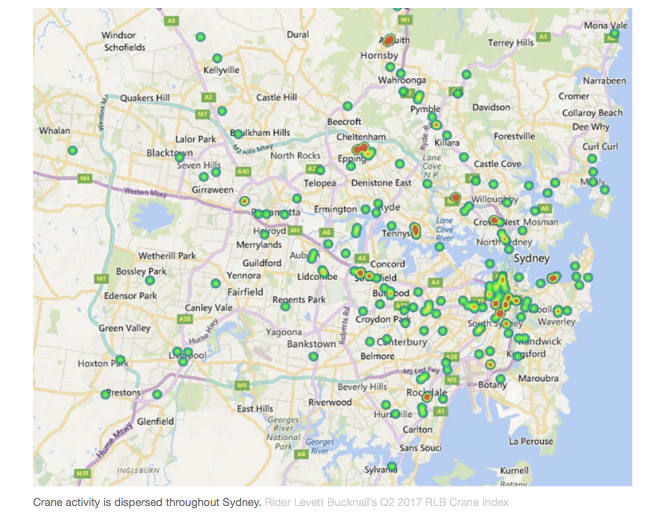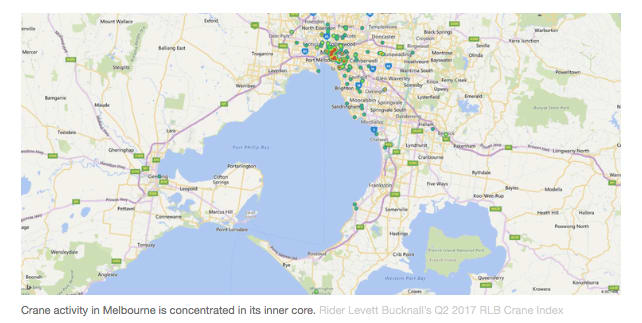Crane-spotting: a way to tell which Australian cities are growing and where
![]() GUEST OBSERVER
GUEST OBSERVER
Crane-spotters rejoice. The 10th Rider Levett Bucknall (RLB) Crane Index® is public. And the news is, well, rather illuminating.
Operating since 2012, the Australian RLB Crane Index® tracks the number of tower cranes in key cities in Australia. Based on the theory that cranes in the sky indicate major project construction, the index gives a simple insight into the construction sector’s health within Australia.
So, what does the 10th edition tell us?
The most obvious message is that if cranes were the only thing that mattered in the competition between the capitals, Sydney would win hands down. Sydney’s skylines are home to more than 50 percent of Australia’s cranes. Melbourne has 22 percent and Brisbane 12 percent, with the remaining 10 percent divvied up between other major cities across the country. While the overall number of cranes in Australia has declined slightly, the index in Sydney and Melbourne continues to rise.

Most cranes are used to construct apartments
But it’s not just the number of these soaring splendours of the sky that is of interest to those keeping an eye on cities. There have also been shifts in the number of cranes dedicated to sector.
The vast majority of cranes (about 84 percent) are used on residential sites – ie. the construction of apartments. Commercial projects come in a pitiful second with 5 percent of crane activity. Other sectors, including health, education, infrastructure and recreation projects, make cameo appearances to make up the remaining 11 percent.
The distribution of cranes amongst project types, however, and the shift in this distribution, is different from city to city. All cities apart from the east coast powerhouses of Sydney and Melbourne experienced a decrease in cranes on residential projects. And the increase in cranes building apartments in Sydney (34) far outstrips any increase in Melbourne (13).
Cranes cluster in Melbourne but spread all over Sydney
Another interesting insight from the index is the geographical dispersal of cranes across cities. The index report contains heat maps showing hot spots for crane activity. Again, the difference in the dispersal of cranes across Sydney compared to Melbourne is particularly telling.


While Sydney’s 292 residential cranes are scattered throughout the entire metropolitan area, Melbourne’s 122 long-armed navvies are more concentrated in its inner urban core.
Why the increases in cranes dedicated to residential construction in Sydney and Melbourne? And why the differences in dispersal versus concentration between the two cities?
The larger apartment blocks which require cranes are expensive to construct – the square-metre rates are at least double the rates of lower-density dwellings. For these larger projects to be feasible, they need to be in a neighbourhood where the price of the finished apartment is still less than the price of a separate dwelling – ie. areas with a higher median house price.
Previously, this situation did not apply to many suburbs. However, the most recent surge in housing prices in Sydney has pushed up prices, rendering high-rise construction feasible in many more areas. This has extended not only the prevalence of high-rise, but also their footprint across the city.
Of course, the price surge has also been experienced in Melbourne, but to a lesser degree and in a more concentrated manner, with Melbourne’s pricier suburbs sticking closely to the inner urban core.
A second reason for the increase and dispersion in Sydney is that many of these larger projects are now approved by Sydney planning panels, rather than by local government. The majority of members of these panels are experts appointed by the planning minister. Hence they avoid the anti-densification tradition that lingers in some local government areas, again enabling approval and construction of high-rise throughout the suburbs.
The RLB crane index is therefore not just a source of fascination for urban crane-spotters. Although it isn’t exactly rigorous evidence of city morphology over time, it’s interesting to look sideways from traditional indices for novel expressions of change.
Jennifer Kent is research fellow, University of Sydney and can be contacted here.
Peter Phibbs is chair of Urban Planning and Policy, University of Sydney and can be contacted here.
Both are authors for The Conversation.
